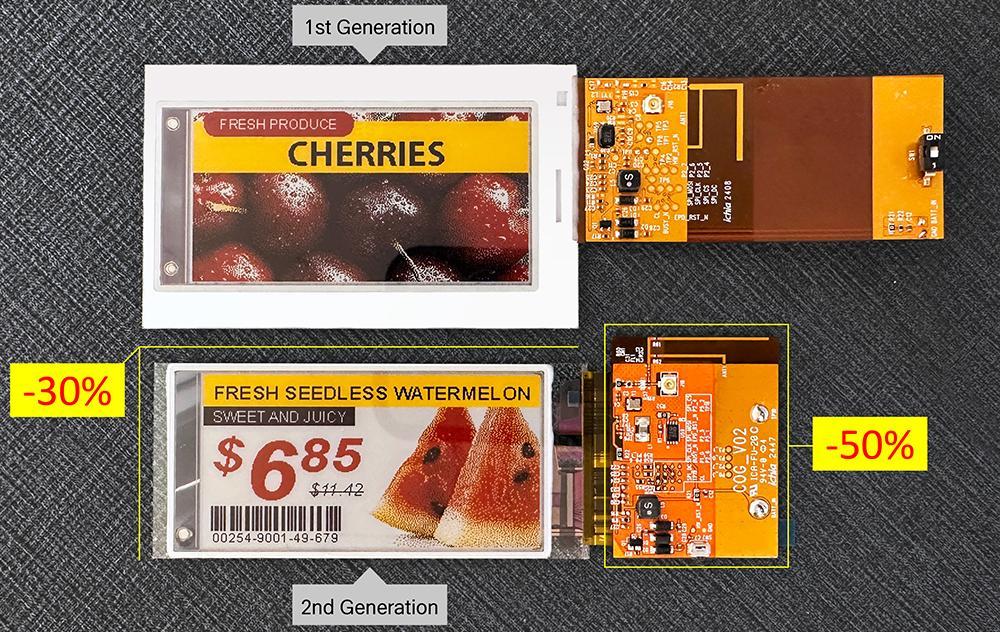E Ink, the originator, pioneer, and global commercial leader in electronic paper (ePaper) technology, announced its collaboration with Realtek Semiconductor to unveil the second-generation System-on-Panel (SoP) electronic shelf label (ESL) reference design.
This innovative solution simplifies ESL development, significantly reducing the barrier to entry. Under identical display areas, the new-generation design achieves approximately a 30% reduction in thin-film transistor (TFT) size and a 50% decrease in flexible printed circuit (FPC) dimensions. This enables streamlined ESLs with slimmer borders perfectly suited for diverse retail environments.
Groundbreaking SoP technology
The groundbreaking SoP technology integrates components directly onto ePaper, glass, or flexible substrates, combining integrated circuits, panels, and system design into a unified ePaper display solution. The second-generation SoP incorporates Realtek’s Bluetooth chipset using Chip-on-Glass (CoG) technology, creating the world’s first device embedding a Radio Frequency Integrated Circuit (RFIC) directly onto glass. This advancement minimises material usage, reduces product size, simplifies manufacturing processes, and delivers a more efficient, environmentally sustainable display solution.
“Electronic shelf labels have replaced traditional paper labels, enhancing efficiency and reducing energy consumption for retailers,” said Johnson Lee, Chairman of E Ink. “Our commitment to advancing ePaper technology remains strong. Following positive feedback on our initial SoP prototypes, we continued innovating to deliver the next-generation design. Our new ESL solution promises improved operational efficiency for retailers and contributes toward carbon reduction efforts.”
The second-generation SoP design increases efficiency through an optimised circuit layout and transmission line architecture, allowing signal transmission distances to approach those of traditional shelf labels. Additionally, the FPC is integrated onto the back of the panel, further reducing the device size and material usage, resulting in a more energy-efficient and eco-friendly ESL solution that aligns with ESG principles for sustainable development. The SoP design integrates an RF chip onto a 2.66-inch e-paper display glass substrate using Realtek Semiconductor’s next-generation Redistribution Layer (RDL) technology, replacing traditional wire bonding packaging. These advancements make it commercially viable, and the deep integration of semiconductors and display panels provides a foundation for the next generation of retail products.
Net-zero carbon emissions by 2040
As a pioneer in ePaper technology, E Ink is dedicated to achieving net-zero carbon emissions by 2040. Beyond the inherent sustainability benefits of ePaper products, E Ink proactively optimizes product designs to enhance environmental friendliness. Furthermore, ESLs significantly reduce carbon emissions. For example, over the past seven years, approximately 600 million 3-inch ePaper labels have been installed globally. Changing pricing information four times daily, traditional paper labels produce 32,000 times more carbon dioxide than ePaper labels. Similarly, 30 million 10-inch electronic advertising displays globally, used continuously for five years, produce 12,000 times more CO₂ emissions if utilising LCD technology compared to ePaper. Compared to disposable printed paper, dynamic ePaper displays emit 60,000 times less CO₂.
The second-generation SoP ESL will be showcased at E Ink’s booth (#L717) during Touch Taiwan 2025 from 16-18 April. Visitors are welcome to experience the latest innovation firsthand.


